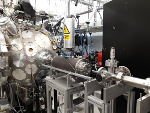| | 1 | = "(Online) range monitoring in particle therapy: status and prospects" - Piergiorgio Cerello (Torino) = |
| | 2 | |
| | 3 | * [#abstract Abstract] |
| | 4 | * [raw-attachment:2019-06-19-Cerello.pptx Slides] |
| | 5 | * Details: |
| | 6 | {{{ |
| | 7 | Date: 19 June 2019 |
| | 8 | Time: 15:00 |
| | 9 | Venue: Room 539, Blackett Lab |
| | 10 | Imperial College London |
| | 11 | Prince Consort Road |
| | 12 | SW7 2BW |
| | 13 | }}} |
| | 14 | == Abstract == |
| | 15 | [=#abstract] |
| | 16 | The intrinsic advantage of Particle Therapy lies in the characteristic dose deposition of ions as a function of the depth: while X-rays lose energy smoothly and mainly exponentially as they penetrate tissue, hadrons deposit almost all of their energy in a sharp peak – the Bragg peak – at the very end of their path. The dose delivered to the cancer can be maximised while, at the same time, preserving the surrounding healthy tissues, as long as the particle range, determined by the beam energy and the properties of the tissues crossed by the beam, is properly tuned to reach the tumour. Range uncertainties or errors, related – for example - to morphological changes during the weeks of the treatment or to patient mispositioning, could cause severe underdosage of part of the tumour or overdosage of healthy tissues close to the tumour. Monitoring the range with high precision (e.g., 1 mm) and in real time (i.e., during the treatment) is a critical issue to improve the reliability and effectiveness of particle therapy. |
| | 17 | Nuclear interactions, taking place for a small fraction of the primary beam particles, provide the signals that can be exploited to monitor the range: prompt photons in the 1-10 MeV range from the decay of excited nuclei, back-to-back 511 keV photons from the annihilation of positrons from β+ decays of unstable isotopes generated in beam-tissue interactions, and, for treatments with ion beams only, protons from beam fragmentation. |
| | 18 | The most recent experimental results will be presented and analysed, and prospects for the design of a new, integrated system for beam delivery, beam monitoring and online range monitoring will be discussed. |
